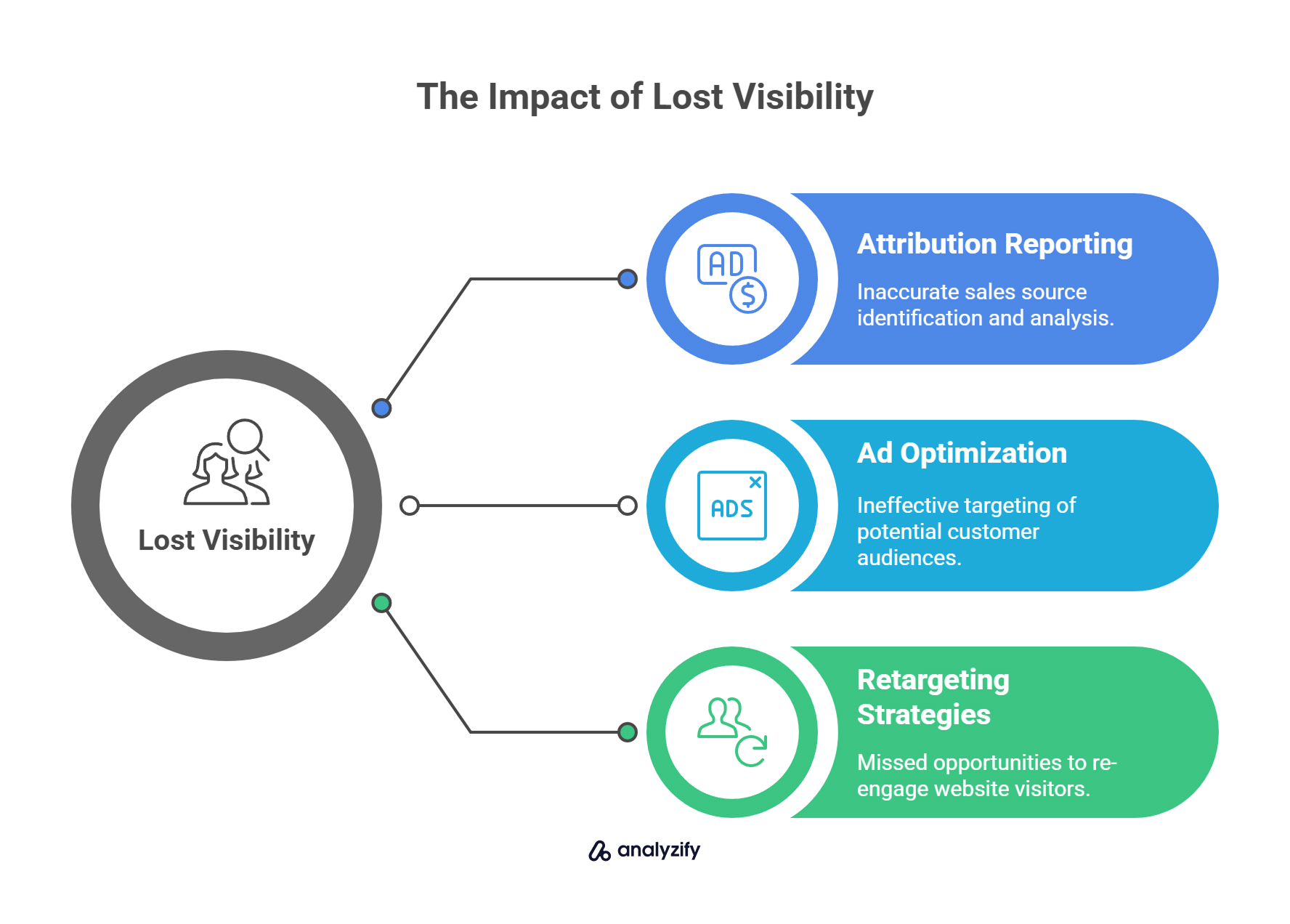If you rely on digital advertising to grow your Shopify store, you’ve probably noticed that tracking isn’t as reliable as it used to be.
That’s no accident.
Privacy-first changes across major browsers (Safari, Firefox, Chrome) and platforms (iOS, Android) are intentionally reducing — and in many cases, blocking — the use of cookies to track user behavior.
Third-party cookies are already heavily restricted, and even first-party cookies are facing stricter lifespans and consent requirements.
The result?
Standard tracking methods are losing visibility into customer journeys.

This impacts:
Attribution reporting (where sales come from)
Ad optimization (which audiences to target)
Retargeting strategies (reaching back out to visitors)
In this guide, we’ll explain the main cookieless tracking methods, evaluate their pros and cons, and show you why server-side tracking stands out as the most practical and effective solution for Shopify businesses in 2025.
Overview: 3 Main Cookieless Tracking Methods
There are three primary methods currently used (or proposed) to adapt to a cookieless future:
Probabilistic Tracking
Browser Fingerprinting
Each approach attempts to preserve tracking capabilities without relying on traditional browser cookies — but they differ significantly in terms of practicality, legality, and effectiveness.
We’ll briefly explore each one — and then focus on the method that makes the most sense for Shopify stores.
Server-Side Tracking: The Most Practical Solution for Shopify
In server-side tracking, events (such as purchases, add-to-cart actions, and form submissions) are sent from your Shopify store’s backend servers — not directly from the customer’s browser.
This changes the flow dramatically:
Instead of relying on fragile browser scripts that cookies, ad blockers, or privacy settings can block, your store communicates events directly to platforms like Google Analytics 4 (GA4), Meta Ads, and TikTok Ads.
Shopify captures the event internally, and then pushes it securely to the destination server using APIs or webhooks.
Because these server-to-server connections bypass the browser entirely, they are far less likely to be blocked or lost.
![]()
Why It’s Effective for Shopify Merchants
Higher Event Reliability: Purchases, checkout steps, and other high-value events are delivered more consistently — even when the user’s browser blocks cookies or disables tracking scripts.
Better Attribution Accuracy: You can see more complete customer journeys, leading to smarter ad optimization and improved ROI.
Reduced Impact from Ad Blockers: Server-side events are not easily stopped by browser-based ad-blocking tools.
Consent Management Alignment: When properly configured (e.g., using Shopify’s Privacy API and Google Consent Mode), server-side tracking can respect GDPR and other privacy regulations while maintaining strong data quality.
Esasy Implementation: Thanks to solutions like Analyzify, Shopify merchants don’t need to manage their own servers — making server-side tracking accessible without heavy technical overhead.
Bonus: Learn more about Benefits of GA4 Server-Side Tracking for Shopify!
Probabilistic Tracking: What It Is and Why It’s Not Enough Alone
Probabilistic tracking doesn’t rely on direct identifiers like cookies or login information.
Instead, it uses statistical modeling to estimate user behavior based on device information (browser type, OS version, screen size), IP address ranges, geographic location, visit timestamps, and other available metadata.
When platforms like Meta or Google Analytics detect gaps in user data — especially after privacy restrictions block direct tracking — they use probabilistic methods to approximate which conversions likely belong to which campaigns.
![]()
Benefits
Fills attribution gaps when deterministic tracking fails, helping platforms estimate conversions even without direct identifiers.
Works without needing personal identifiers, since modeling is based on behavioral and device patterns rather than user data.
Limitations
Provides lower accuracy compared to direct matching, because estimations are statistical, not confirmed.
Cannot be controlled or implemented by merchants, as it operates entirely inside ad platform algorithms (Meta, Google, TikTok).
Does not recover event-level visibility, meaning you can’t trace exact purchases or customer actions when data is missing.
Probabilistic tracking is useful for platforms trying to bridge attribution gaps — but it’s not a direct tool that Shopify merchants can control or rely on for precise marketing data.
Browser Fingerprinting: Why It’s Risky for Shopify Stores
Browser fingerprinting attempts to uniquely identify users based on their device and browser configurations — including factors like screen resolution, installed fonts, browser version, operating system, language settings, and plugin installations.
By combining enough of these seemingly minor details, a platform may create a “fingerprint” that uniquely identifies a visitor — even without cookies.
![]()
Benefits
- Bypasses reliance on cookies for user tracking, theoretically allowing some level of visitor identification without cookie consent.
Limitations
Raises major privacy and legal concerns, being classified as invasive under GDPR, CCPA, and similar regulations.
Creates legal risk for Shopify merchants, because fingerprinting often violates user consent requirements and could lead to fines.
Is not supported by Shopify’s platform, which encourages merchants to stay privacy-compliant and avoid unauthorized tracking methods.
Is unstable and unreliable for consistent tracking, as users can easily block, reset, or randomize fingerprinting attempts.
✅ Although fingerprinting might seem attractive for bypassing cookie restrictions, it’s legally risky, technically unstable, and not recommended for Shopify merchants aiming for sustainable growth.
Why Server-Side Tracking Makes the Most Sense for Shopify in 2025
Now that we’ve evaluated the main cookieless tracking approaches, the strongest path forward becomes clear:
Probabilistic tracking helps platforms estimate some data loss — but it’s a behind-the-scenes modeling process that merchants can’t control or optimize manually.
Browser fingerprinting introduces serious privacy risks and legal exposure, making it unsuitable for responsible, growth-focused Shopify stores.
![]()
Server-side tracking, however, offers Shopify merchants a real, actionable solution:
Direct event delivery from Shopify to GA4, Meta, TikTok, and others — minimizing losses from cookies, ad blockers, and browser restrictions.
Stronger consent management by aligning with privacy frameworks like Shopify’s Customer Privacy API and Google Consent Mode v2.
Real ownership of your tracking setup, without relying solely on platforms’ black-box modeling.
Smoother implementation, thanks to apps like Analyzify that make server-side adoption accessible without needing cloud server management.
 Built for Shopify - No Dev Work Required - Fast Setup
Built for Shopify - No Dev Work Required - Fast Setup 
Start Tracking Shopify Orders Accurately!
Let Analyzify's enhanced server-side tracking provide you with more accurate & reliable attribution data - setup in 10-15 minutes.In 2025, sustainable attribution and ad optimization for Shopify merchants will increasingly depend on first-party data capture combined with server-side event delivery — not workarounds like fingerprinting or blind reliance on probabilistic models.
Final Thoughts: Cookieless Tracking on Shopify Is Here — and You Can Be Ready
The era of easy cookie-based tracking is over — but that doesn’t mean you have to lose visibility, waste ad spend, or fly blind.
Shopify merchants who want to stay competitive in 2025 and beyond need a tracking setup that:
Respects user privacy
Works even when cookies and scripts fail
Enables better ad optimization and attribution reporting
Server-side tracking — especially when properly implemented and consent-aware — is the clearest, most sustainable path forward.
Analyzify makes this future accessible without the technical headaches.
✅ You protect your data.
✅ You respect your customers.
✅ You empower your marketing performance.
Bonus: Explore how to Fix Your GA4 & Meta Tracking!
Ready to Future-Proof Your Shopify Tracking?
 Built for Shopify - No Dev Work Required - Fast Setup
Built for Shopify - No Dev Work Required - Fast Setup 
Standart Tracking Methods Aren't Enough for Shopify
Let Analyzify combine client-side and server-side tracking. So you capture every important event, even when browser script fail.Make your next move — and track smarter for the cookieless future.
































